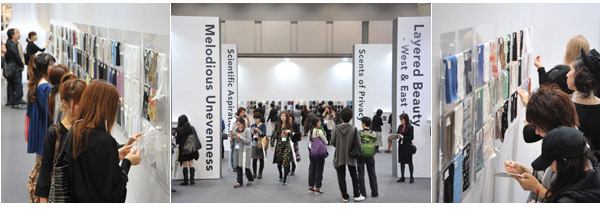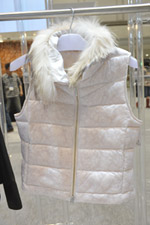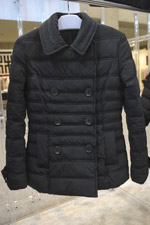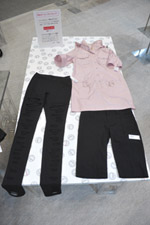| |
 |
| |
 |
| |
In spite of the poor weather on the opening day, a long queue was formed at the entrance. The hall had a very vivid atmosphere all day long. The Trend Index Corner, of which the main theme is “A Sense of Incompatibility>>>Original”, attracted many visitors from the sectors of apparel, retail designers, merchandisers, etc. At JFW-JC, the visitors were able to gain the signs of next year’s autumn/winter trends.
The Japan Jeans Association participated with “Jeanism Japan Quality” on a big scale for the first time. Also attracting many visitors were “Silk & Synthetic” by the Japan Silk & Rayon Weavers’ Association, “Material Adventure” by the Tango Textile Industries Association/Tango Fashion Week Executive Committee, and “Pigskin Corner” by the Tokyo Metropolitan Leather Technology Center.
The exhibits are more advanced in technology and originality. For instance, Philknot Co., Ltd. is displaying shining materials using optical fiber and embroidery techniques. Hayashiyo Co., Ltd. is presenting high-density linen fabrics that can be used all year round. Cloth Japan is creating original fabrics based on discussions with clients in regard to trial woven fabrics and color simulation. Mokuba Co., Ltd. is offering sample cuts (swatches of up to 10 cm), and is exhibiting about 20,000 varieties including new products. Asahi Fastener Co., Ltd. is showing replicas of vintage “Zipper” from the 1940s to 1950s. Regardless of the booth size, interesting topics were witnessed here and there.
There were also small and attractive booths. Among the dyeing and processing booths, various processing methods are being proposed, and visitors can touch and feel the exhibits with their hands and listen to explanations while taking notes in their notebook.
“Jeanism Japan Quality” has prepared an indigo dyeing corner where visitors can dye original designs on handkerchiefs. Shima Seiki Mfg., Ltd. is demonstrating order-made production. From a variety of design samples and materials, the desired yarns are selected, and an original piece of knitwear is made without sewing. These demonstrations are drawing large audiences.
|
| |
 |
| |
 |
| |
Prizes Are Determined by Voting on Site!
Best of TA-KU-MI, JFW Japan Creation Grand Prix was founded to certify textile works excelling in both sensitivity and techniques, with aims to further develop the potentials of Japanese textiles as well as new and excellent designers, and to further support textile creation, and undertake promotion both inside and outside Japan. A total of 60 items that passed primary and secondary examinations are on display, and the winners are determined based on votes from JFW-JC coordinators, Shinmai creators and special guest buyers.
Among the opinions of the judging committee are: “Products produced on state-of-the-art looms also have the latest look.” “All of the works are marketable and not impractical, including student pieces.” “The display methods are attractive.” “The lighting effects contribute a lot to the shadow and appearance of fabrics, and it’s easier to see than on a flat plane.” “It’s hard to decide the final five awards, and maybe more awards should be added,” etc.
The final winners will be announced at the business communication meeting on November 4th.
|
| |
 |
| |
 |
| |
One of the purposes of Japan Fashion Week (JFW) in Tokyo is to provide an occasion for novice designers around the world to make their debut. “Shinmai” is a Japanese word for novice. The Shinmai Creator’s Project was started in 2008.
This is the second year, and applications were received from 37 groups from 11 nations. By the final examination on July 16th, the following four brands were selected.
A Degree Fahrenheit (Yu Amatsu)
Akane Utsunomiya (Akane Utsunomiya)
Fabiola Arias (Fabiola Arias)
The Individualists (Louise SCHWARZE and Frank POUCHOULIN)
On the first day of JFW-JC, October 7th, a press conference was held for the Shinmai Creator’s Project. Five designers from four brands will be given a chance to exhibit the own works made from materials selected at JFW-JC at the Shinmai Creator’s Project Collection in March 2010.
At the press conference, Amatsu said, “I’ll do my best at the March collection by using the excellent materials of Japan.” Utsunomiya followed, “I came back from London a year ago. I want to express my own sensibility to the younger generation.” Arias confessed, “Only basic materials are available in the United States, and it’s a bit a chance for me to use Japanese materials.” Schwartz and Pechelin agreed, “We used Japanese textiles in our last three collections. It’s great fun to come to Japan and select excellent Japanese textiles.”
|
| |
 |
| |
 |
| |
Piggy’s Special, a pigskin fashion show using Tokyo-made pigskin, was organized by the Tokyo Metropolitan Leather Technology Center, and was held on October 7th, twice at 13:30 and 15:00. This collection is also famous for selecting new designers representing Tokyo. This time, two brands were invited, Akira Naka and Mikiosakabe.
Akira Naka had “Crossgender” as the main theme, and presented a combination of pigskin using black stretch material and glossy finishing to express a modern elegance of masculine and feminine taste.
Mikiosakabe followed the images of girls of rock and heavy metal freaks in the 1990s, and created a theme of “Twilight”. An emphasis was placed on the difference between gloss and non-gloss, hard and soft, and volume and fitness, by virtue of creating various expressions of pigskin in combination with a simple cut-off T-shirt.
On Thursday, October 8th, shows by fashion school students in Tokyo will be held twice at 13:30 and 15:00.
(Interviews after Piggy’s Special)
MIKIOSAKABE
Up to now, leather had been mainly bovine leather. This time, I found pigskin to be similarly useful. There are many experienced pigskin manufacturers, and the results were what I expected or even better. I combined it with stretch materials to express lightness and fitness, and I had a hard time finding a good apparel manufacturer, but the first samples were better than I expected.
AKIRA NAKA
I used to think that pigskin was heavy and its pores were remarkable, but I have no such a negative image about pigskin any more. Several companies and manufacturers have made improvements and modifications to pigskin, and all of the materials were sufficiently usable from the beginning. I was often surprised at the unimaginable quality of pigskin. In the past, I tried lamb, horse and cow hide, but I now find pigskin to be different and interesting. Instead of bags and accessories, I want companies to feel the good use of pigskin in apparel. This time, I have placed an emphasis on reality, expecting to share the same feeling with people in related industries.
|
| |
 |
| |
 |
| |
In the forums that started from October 7th, Mr.Yoshiharu Nakamura, Chief, Editorial Dept., Editorial Head Office, Senken Shimbun Co., Ltd., gave a lecture on changes in fashion business during the last ten years and future spending patterns. He declared 1998 as the first year of casual fashion. According to Mr.Nakamura, in the past when retailers suffered from slumping sales, net sales showed dramatic growth, and fashion business has been drastically changing during the past ten years. As for future spending, he says, “We must continue to pay attention to young ‘feminine’ men in their twenties and active women in their forties.” The following is a summary of his lecture.
| - |
From 1997 to 2008, apparel sales at department stores dropped 2,700 billion yen, and sales at mass-merchandisers also fell by more than 50 percent. Department store sales amounted to 7,380 billion yen in 2008, and were overtaken by shopping centers by 7,850 billion yen. |
| - |
According to various data, Internet sales have reached a similar level to department stores, and outlet sales have also reached 500 billion yen.
- Since 1998, fashion business in Japan has been showing radical changes. Such changes are not limited to the retail market, and are seen everywhere in the background of a decrease in children, an older society and the fall of the middle-income class.
|
| - |
Since 1998, fashion business in Japan has been showing radical changes. Such changes are not limited to the retail market, and are seen everywhere in the background of a decrease in children, an older society and the fall of the middle-income class. |
| - |
In the future, spending is likely to show further changes. People are newly consciousness about ecology and energy, as well as have in mind not to possess things and “mottainai” campaign, in addition to consumer psychological changes. On the other hand, women are seeking sure investment values (maintenance resorts), and there are also people seeking happiness in their daily life. |
|
| |
 |
| |
 |
| |
Nowadays, jeans with price tags of about 800 yen are being sold in Japan. In these days of low price competition, the Japan Jeans Association is proposing the true quality of jeans under the theme “Jeanism Japan Quality”.
Quality is not limited to material quality alone, but includes the background and tradition of manufacturing, and goes even further to the level of mental and physical safety including Ecology and CSR. At JFW-JC, materials, processing, auxiliary materials and products are introduced, and visitors can experience “indigo dyeing” by dyeing their own favorite designs.
The 400-square-meter booth at JFW-JC includes corners for raw materials, finished products, auxiliary materials, ecology and indigo. The Raw Material Corner displays cotton spinning, regenerated fibers and the latest materials. The Finished Product Corner is full of the latest products from national brands. The Auxiliary Material Corner presents products and environment-friendly articles developed by various companies. The Ecology Corner introduces environment-conscious processing, eco jeans, etc.
[Participating Companies] Azuma Co., Ltd.; Itochu Corporation; Edwin Co., Ltd.; Kaihara Corporation; Kurabo Industries Ltd.; Gunze Limited; Takaya-Shoji Co., Ltd.; Tentac Co., Ltd.; Tokyo Yoshioka Co., Ltd.; Toyobo STC Co., Ltd.; Naxis Corporation; Nishinbo Textile Inc.; Nihonmenpu Co., Ltd.; Big John Co., Ltd.; Fukui Co., Ltd.; Betty Smith Co., Ltd.; Howa Co., Ltd.; Mitsubishi Corporation; Mitsuboshi Corporation; Moririn Co., Ltd.; Lee Japan; Lenzing Fiber; YKK Snap Fasters Japan; and YKK Fastening Products Sales Inc.
|
| |
 |
| |
 |
| |
Uni Textile Co., Ltd. (Promotion Zone C-13)
“Japanese-made silk/cotton blended prints priced at less than 1,000 yen”
A major topic is that Uni Textile is offering silk/cotton blended fabrics that are printed in Japan at less than 1,000 yen per meter. Six fabric constructions are available, including chiffon, tulle, satin, yoryu crepe, etc. Uni Textile is famous for its polka dot patterns, and is newly presenting animal patterns in association with the recent trends. About 60 patterns are on display this time.
In addition, Uni Textile will hold its own exhibition on October 15th and 16th at La Collezione in Omote Sando, Tokyo.
|
| |
Hironen Co., Ltd. (Business Textile Zone E-43)
“Many inquiries received from European brands”
At the previous JFW-JC, Hironen attracted considerable attention for its presentation of “color balls” made from fiber-dyed PTT (polytrimethylene terephthalate, Solotex). The company received many inquiries from Japanese firms, as well as from leading European brands. Negotiations are in progress at the moment. The products are highly evaluated from the viewpoint of “animal-free” philosophy, not killing birds, in addition to fashion aspects.
Mr.Masahiro Suzuki, the company official and Tokyo Branch Director, says, “JFW-JC is important because new proposals are in demand, and it also leads to new business opportunities.”
At the current JFW-JC, new products are being presented, such as a stretchable down jacket made from “color ball” and a flexible and functional two-way tricot made from “Merryl” nylon for leggings.
 |
 |
 |
A “color ball” down vest
made with dyed Solotex fibers |
A stretchable down jacket
made from “color ball” |
A two-way tricot
made from Merryl nylon for leggings |
|
| |
 |
| |
 |
| |
A press conference for JFW-JC was held on October 7th.
In spite of the difficult economic environment, the show had exhibitors amounting to 279 firms and 393 booths, as compared with 277 firms and 482 booths for the 2009 A/W show. New and returning participants numbered 72 firms and 75 booths, more than double the figure of ordinary years. Mr.Yoshiharu Kaihara, Chairman of the Exhibition Committee, recognized that the efforts for JFW-JC were appreciated.
According to an official announcement, the business communication meeting (reception) and the industrial-academic exchange party will be held on Tuesday, November 4th, after the exhibition, at TEPIA in Aoyama, Tokyo, and not during the exhibition period as in the past. At the press meeting, the awards for the Best of TA-KU-MI and Form Presentation will be announced.
Another press conference is planned, and the results of the current JFW-JC show and JFW-JC in Shanghai from October 20th to 23rd will be reported.
|
|
